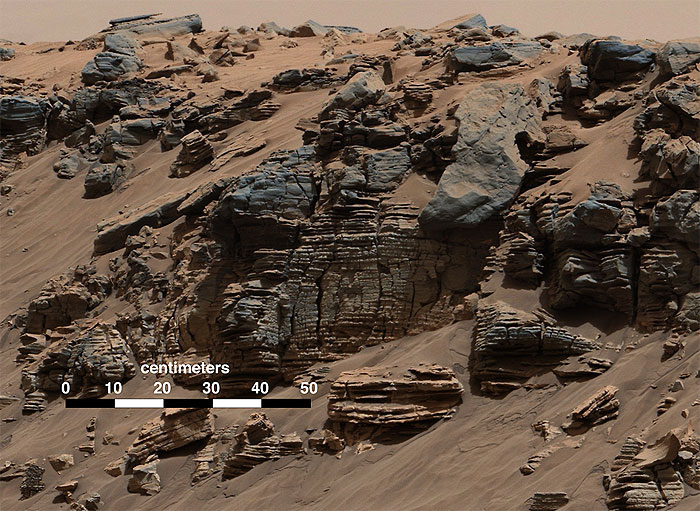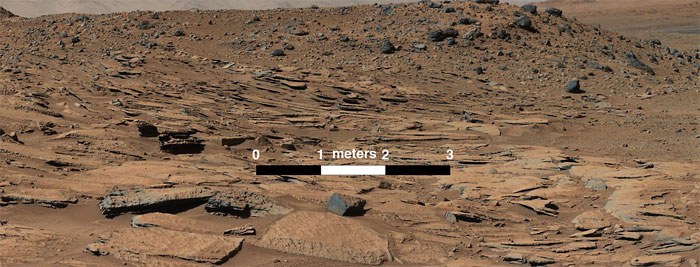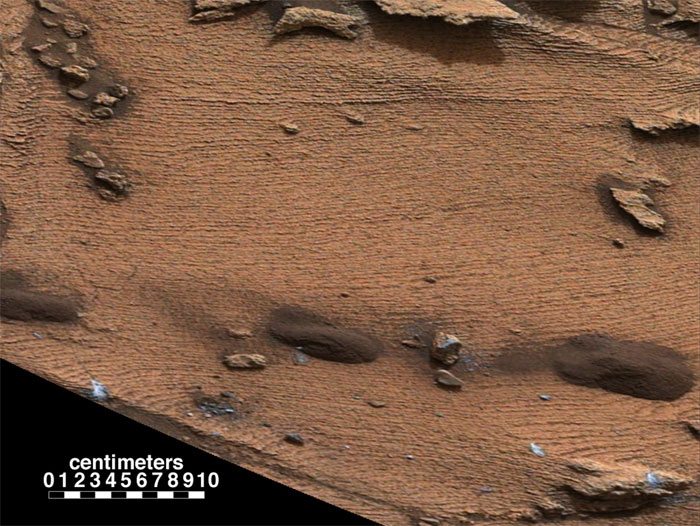.

This illustration depicts a lake of water partially filling Mars' Gale Crater, receiving runoff from snow melting on the crater's northern rim.
Image Credit: NASA/JPL-Caltech/ESA/DLR/FU Berlin/MSSS
.
Observations by NASA’s Curiosity Rover indicate Mars' Mount Sharp was built by sediments deposited in a large lake bed over tens of millions of years.
This interpretation of Curiosity’s finds in Gale Crater suggests ancient Mars maintained a climate that could have produced long-lasting lakes at many locations on the Red Planet.
"If our hypothesis for Mount Sharp holds up, it challenges the notion that warm and wet conditions were transient, local, or only underground on Mars,” said Ashwin Vasavada, Curiosity deputy project scientist at NASA's Jet Propulsion Laboratory in Pasadena. “A more radical explanation is that Mars' ancient, thicker atmosphere raised temperatures above freezing globally, but so far we don't know how the atmosphere did that."
Why this layered mountain sits in a crater has been a challenging question for researchers. Mount Sharp stands about 3 miles (5 kilometers) tall, its lower flanks exposing hundreds of rock layers. The rock layers – alternating between lake, river and wind deposits -- bear witness to the repeated filling and evaporation of a Martian lake much larger and longer-lasting than any previously examined close-up.
"We are making headway in solving the mystery of Mount Sharp," said Curiosity Project Scientist John Grotzinger of the California Institute of Technology in Pasadena, California. "Where there's now a mountain, there may have once been a series of lakes."
Curiosity currently is investigating the lowest sedimentary layers of Mount Sharp, a section of rock 500 feet (150 meters) high dubbed the Murray formation. Rivers carried sand and silt to the lake, depositing the sediments at the mouth of the river to form deltas similar to those found at river mouths on Earth. This cycle occurred over and over again.
"The great thing about a lake that occurs repeatedly, over and over, is that each time it comes back it is another experiment to tell you how the environment works," Grotzinger said. "As Curiosity climbs higher on Mount Sharp, we will have a series of experiments to show patterns in how the atmosphere and the water and the sediments interact. We may see how the chemistry changed in the lakes over time. This is a hypothesis supported by what we have observed so far, providing a framework for testing in the coming year."
After the crater filled to a height of at least a few hundred yards and the sediments hardened into rock, the accumulated layers of sediment were sculpted over time into a mountainous shape by wind erosion that carved away the material between the crater perimeter and what is now the edge of the mountain.
On the 5-mile (8-kilometer) journey from Curiosity’s 2012 landing site to its current work site at the base of Mount Sharp, the rover uncovered clues about the changing shape of the crater floor during the era of lakes.
"We found sedimentary rocks suggestive of small, ancient deltas stacked on top of one another," said Curiosity science team member Sanjeev Gupta of Imperial College in London. "Curiosity crossed a boundary from an environment dominated by rivers to an environment dominated by lakes."
Despite earlier evidence from several Mars missions that pointed to wet environments on ancient Mars, modeling of the ancient climate has yet to identify the conditions that could have produced long periods warm enough for stable water on the surface.
NASA's Mars Science Laboratory Project uses Curiosity to assess ancient, potentially habitable environments and the significant changes the Martian environment has experienced over millions of years. This project is one element of NASA's ongoing Mars research and preparation for a human mission to the planet in the 2030s.
"Knowledge we're gaining about Mars' environmental evolution by deciphering how Mount Sharp formed will also help guide plans for future missions to seek signs of Martian life," said Michael Meyer, lead scientist for NASA's Mars Exploration Program at the agency's headquarters in Washington.
JPL, managed by the California Institute of Technology, built the rover and manages the project for NASA's Science Mission Directorate in Washington.
.

Sedimentary Signs of a Martian Lakebed
This evenly layered rock photographed by the Mast Camera (Mastcam) on NASA's Curiosity Mars Rover shows a pattern typical of a lake-floor sedimentary deposit not far from where flowing water entered a lake.
The scene combines multiple frames taken with Mastcam's right-eye camera on Aug. 7, 2014, during the 712th Martian day, or sol, of Curiosity's work on Mars. It shows an outcrop at the edge of "Hidden Valley," seen from the valley floor. This view spans about 5 feet (1.5 meters) across in the foreground. The color has been approximately white-balanced to resemble how the scene would appear under daytime lighting conditions on Earth. Figure A is a version with a superimposed scale bar of 50 centimeters (about 20 inches).
This is an example of a thick-laminated, evenly-stratified rock type that forms stratigraphically beneath cross-bedded sandstones regarded as ancient river deposits. These rocks are interpreted to record sedimentation in a lake, as part of or in front of a delta, where plumes of river sediment settled out of the water column and onto the lake floor.
.

Inclined Martian Sandstone Beds Near 'Kimberley'
This image taken by the Mast Camera (Mastcam) on NASA's Curiosity Mars rover just north of the "Kimberley" waypoint shows beds of sandstone inclined to the southwest toward Mount Sharp and away from the Gale Crater rim. The inclination of the beds indicates build-out of sediment toward Mount Sharp. These inclined beds are interpreted as the deposits of small deltas fed by rivers flowing down from the crater rim to the north and building out into a lake to the south, where Mount Sharp is now.
The Mastcam's left-eye camera recorded the component frames of this mosaic on March 13, 2014, during the 569th Martian day, or sol, of Curiosity's work on Mars. The color has been approximately white-balanced to resemble how the scene would appear under daytime lighting conditions on Earth. Figure A is a cropped version with a superimposed scale bar of 3 meters (about 10 feet).
.

Bedding Pattern Interpreted as Martian Delta Deposition
This view from the Mast Camera (Mastcam) on NASA's Curiosity Mars rover looks southward at the Kimberley waypoint. In the foreground, multiple sandstone beds show systematic inclination to the south suggesting progressive build-out of the sediments toward Mount Sharp.
At this location, about a mile (1.6 kilometer) north of the base of Mount Sharp, these inclined beds can be traced up to about 100 yards or meters in the direction of build-out. These inclined beds are interpreted as small deltas building out into a shallow lake. As sediment-laden river water encountered a standing body of water, the river current was forced to abruptly decelerate, leading to rapid deposition of sediment at the river mouth. This deposition led to formation of a delta. Continued supply of sediment by rivers flowing from the crater rim led to deltas building out into the lake towards the south.
The Mastcam's left-eye camera recorded the component frames of this mosaic on March 25, 2014, during the 580th Martian day, or sol, of Curiosity's work on Mars. The color has been approximately white-balanced to resemble how the scene would appear under daytime lighting conditions on Earth. This version has a superimposed scale bar of 50 centimeters (about 20 inches) in the foreground and a scale bar of 3 meters (about 10 feet) at upper right.
.

This image shows an example of a thin-laminated, evenly stratified rock type that occurs in the "Pahrump Hills" outcrop at the base of Mount Sharp on Mars. The Mastcam on NASA's Curiosity Mars rover acquired this view on Oct. 28, 2014. This type of rock can form under a lake.
Quelle: NASA
4791 Views
